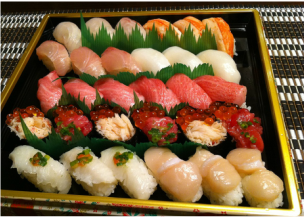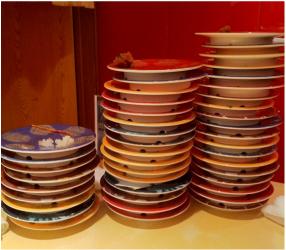
It's one of the most common questions I get asked about living in Japan. The answer to it, like most things is, it depends (unless you were traveling to Tokyo in the 1980s during 'The Bubble' when everything was so inflated that people were literally making it rain in the streets and taking baths in Dom Pérignon). These days though, I'm pretty sure San Francisco has dethroned Tokyo as one of the most expensive places to live, notably when it comes to basic necessities like food and housing. I actually almost considered re-relocating back to Tokyo after I discovered how much it would cost to rent a place in SF.
Japan can be expensive, but that's only for specific types of restaurants. If you're perusing the 3 star section in Michelin guide and looking for Sukiyabashi Jiro, then Tokyo's going to be pricey. Non-Japanese cuisine like French/American/Italian tend to be a bit pricier for dinner (sorry guys no unlimited apps at TGIFridays for $10).
Fresh produce, specifically fruits, will be very expensive especially when you consider the quantity you're paying for. If you're in the market for a triangle shaped watermelon or a handful of white strawberries pristinely packaged like jewelry, then yes, unfortunately, Japan is going to break the bank.
If you don't fall into any of those above categories and you're totally okay with extremely delicious, satisfying, and unpretentious food, then I'm here to tell you that Tokyo and Japan is perfectly affordable, and for me at least, the greatest place to eat in the world, based on a pure cost : quality : satisfaction ratio (notice how I left out quantity) .
Japan can be expensive, but that's only for specific types of restaurants. If you're perusing the 3 star section in Michelin guide and looking for Sukiyabashi Jiro, then Tokyo's going to be pricey. Non-Japanese cuisine like French/American/Italian tend to be a bit pricier for dinner (sorry guys no unlimited apps at TGIFridays for $10).
Fresh produce, specifically fruits, will be very expensive especially when you consider the quantity you're paying for. If you're in the market for a triangle shaped watermelon or a handful of white strawberries pristinely packaged like jewelry, then yes, unfortunately, Japan is going to break the bank.
If you don't fall into any of those above categories and you're totally okay with extremely delicious, satisfying, and unpretentious food, then I'm here to tell you that Tokyo and Japan is perfectly affordable, and for me at least, the greatest place to eat in the world, based on a pure cost : quality : satisfaction ratio (notice how I left out quantity) .
Here are a few tips on what to look out for. Hopefully, this helps a bit with navigating the insane amount of options available. I frequented many of these daily when I was living there. Most are easily accessible, affordable, and best of all, delicious! I truly believe, more so now, after moving back to SF that Tokyo has an unparalleled variety at different price points with each offering consistently high-quality food at reasonable prices. It's probably one of the things I miss most about eating in Japan. There is an incomparable amount of choice at whatever price you're interested in eating at.
| Noodles My favorite quick, easy and oh-so-comforting bite. Ramen, Soba, Udon, Yakisoba - there's just an infinite amount of variation to these staples. Ramen and Soba normally cost between $7 to $10, Udon is ridiculously affordable with some places selling just the noodles for $3 and charging extra for all the different toppings. You'll be able to get a good bowl of noodles almost anywhere and some places even serve lunch specials with a small rice bowl. |
| Set lunch specials Most restaurants open during lunch have set lunch specials that offer meals at extremely affordable prices. This even includes higher-end type establishments that may serve a cheaper lunch set to attract customers in hopes that they will return for dinner - one of the luxuries of having such a competitive food scene. If the food isn't good and affordable (or just down right extraordinary), then most customers will find little reason to return. It's a win-win for us, the hungry customer, looking for the best food at the most reasonable prices. |
 The bento section at your local 7-11
The bento section at your local 7-11 Convenience stores
They are everywhere, always open, and have mind-boggling levels of variety. The quality is pretty high considering where you're buying it. No 3 day old sandwiches here. They have a variety of seasonal bentos, riceballs, salads, soups, and pastas constantly on sale. Near the cash register, fried items like karaage (fried chicken), corn dogs called "American Dogs" in Japan, and yakitori are sold. If you're lucky you might be able to find my favorite... FRIED TAKOYAKI. You'll never be able to eat normal takoyaki again... I practically lived off of food from 7-11 for the first year of my life in Tokyo. Nothing beats eating hot oden (a sort of hotpot of random things like fishcake, daikon, sausage, eggs boiled in a soy dashi soup) at 7am on a chilly Winter morning after working a loooong night shift.
They are everywhere, always open, and have mind-boggling levels of variety. The quality is pretty high considering where you're buying it. No 3 day old sandwiches here. They have a variety of seasonal bentos, riceballs, salads, soups, and pastas constantly on sale. Near the cash register, fried items like karaage (fried chicken), corn dogs called "American Dogs" in Japan, and yakitori are sold. If you're lucky you might be able to find my favorite... FRIED TAKOYAKI. You'll never be able to eat normal takoyaki again... I practically lived off of food from 7-11 for the first year of my life in Tokyo. Nothing beats eating hot oden (a sort of hotpot of random things like fishcake, daikon, sausage, eggs boiled in a soy dashi soup) at 7am on a chilly Winter morning after working a loooong night shift.
 From the Yokohama station Eki-chika. After the price cut, it came up to less than $20.
From the Yokohama station Eki-chika. After the price cut, it came up to less than $20. Supermarkets \ Depa-chika \ Eki-chika
Japanese supermarkets and Depa-chika (translated as under the department store) are modern marvels of convenience and can be found at the bottom floor of almost any major department store. The ones located under larger train stations are called Eki-chika. The majority of them are extremely clean and have a ridiculous variety of food. Chinese, Italian, Japanese, German, yakitori, fried everything, you name they probably have it. I can easily spend hours just walking around a few of them marveling at all the different types of food and figuring out how to maximize my satisfaction by trying as much as possible in a visit. It sounds a bit illogical, but fish sold at these locations are fresh - fresher then anything you'll find stateside at any super market. Sashimi is always a great option and sushi is very decent especially after "time sales" when they cut prices by as much as 50% or more a few hours before closing.
Japanese supermarkets and Depa-chika (translated as under the department store) are modern marvels of convenience and can be found at the bottom floor of almost any major department store. The ones located under larger train stations are called Eki-chika. The majority of them are extremely clean and have a ridiculous variety of food. Chinese, Italian, Japanese, German, yakitori, fried everything, you name they probably have it. I can easily spend hours just walking around a few of them marveling at all the different types of food and figuring out how to maximize my satisfaction by trying as much as possible in a visit. It sounds a bit illogical, but fish sold at these locations are fresh - fresher then anything you'll find stateside at any super market. Sashimi is always a great option and sushi is very decent especially after "time sales" when they cut prices by as much as 50% or more a few hours before closing.
| Donburi Stuff served on top of rice - Atkins and Paleo dieters beware. The ultimate Japanese comfort food and probably not the best idea if you're trying to watch those carbs, but it's Japan... so there's no getting away from it, plus it just tastes soooo good. Food served over rice tends to be very affordable. Look out for things like chirashi, sashimi served over rice, katsu-don (pork cutlet), oyako-don (chicken and eggs), and tempura. This segue-ways nicely into the next topic.. Japanese chain restaurants They do such amazing job of serving slow food, very fast and efficiently for affordable prices. I can't say enough about the quality, value, and efficiency of these chains. I wouldn't feel too much guilt about having this type of food every week. Most offer sets that include pickles, a small salad, and miso soup for a balanced Japanese fast food meal. Majority are open 24 hours in case you need something to fill up on after a long night of drinking. Yoshinoya - My favorite Japanese beef bowl chain, thinly sliced beef and onions braised in a sweet and savory soy based sauce over rice. The best $4 you'll ever spend on a meal. Tenya - Another favorite, they serve perfect tempura with secret sauce over rice for less than $8 a bowl. A super hi-tech machine allows them to mass fry everything to perfection and pump out delicious tempura rice bowls in less than a few minutes. The tempura is so good here that I haven't even tried eating at a proper tempura restaurant yet. Nakau - This is a great chain if you're looking for a few more options than just a beef bowl. They do a really good oyako-don (chicken and creamy eggs over rice), as well serving serviceable udon, soba, tempura, tonkatsu, and Japanese curry. Japanese Denny's - which I wrote about previously, is an excellent choice for lunch or dinner. One of the better "family restaurants" that serves a hodgepodge of cuisines and is surprisingly tasty. It's the one place you'll be able to find something for every one! |
| Kaiten-zushi (Conveyor belt sushi) A very good option if you're on a budget and not confident about walking into any sushi restaurant. Don't be afraid to order directly from the Sushi chef - the items rotating on the conveyor belt are generally just for show to give customers inspiration on what to order. Maguro-bito is one of my favorite, located in Asakusa. I always leave there satisfied when I want to pig out on sushi. |
| Yakiniku (Japanese BBQ) Wagyu or Japanese beef, is one of the most delicious things in the world. Some people refer to it as "Kobe beef", but generally in Japan all beef raised domestically is very comparable. There are different levels to rank the beef based on fat marbling but otherwise Kobe is just a branding thing. That being said, Yakiniku is a great option especially for a nice group dinner. You'll have to be careful though because there are some places that are very expensive. If you check the menu and every plate costs more than $10 or 20, it's probably a higher-end restaurant. Here's one of my favorite cheap and good Yakiniku restaurants in Shibuya, Shichikosan. It's absolutely tiny, but the beef is good and the drinks are cheap. |
Gallary of some other random favorites

















